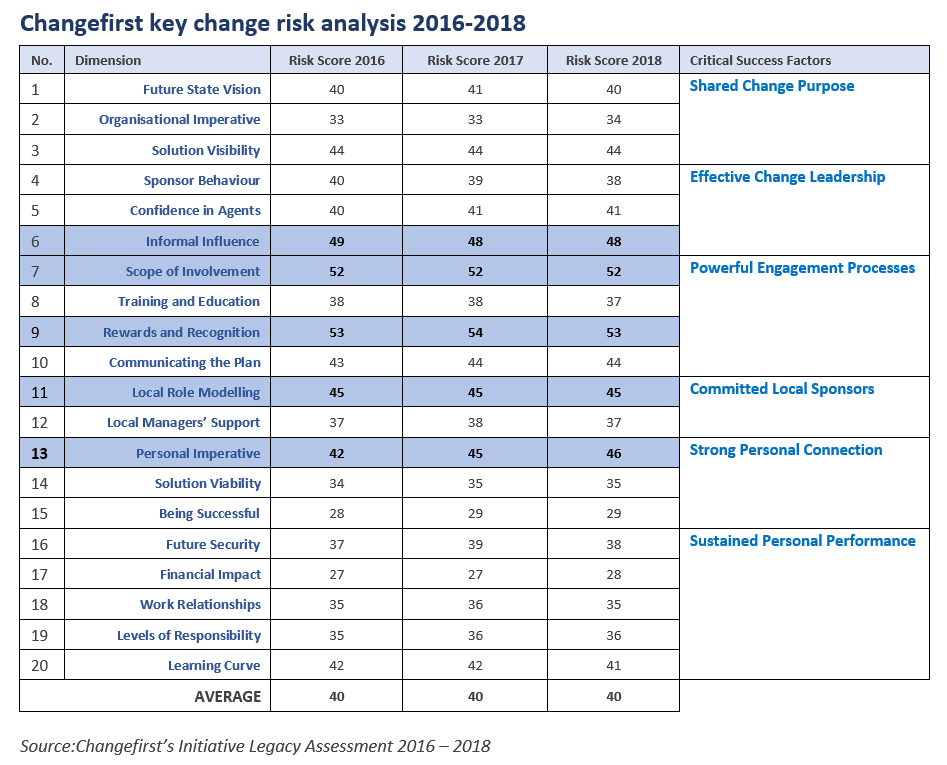
In our last post we talked a lot about the importance of using change management data from the past to shape and guide future change planning.
With the demands of digital transformation and constant change now a given in many organisations, an environment with a history of implementation success is likely to be more welcoming of new change projects – and more capable of delivering them. Collective memory in an organization also matters – so what is our most recent change management research in our Power of Data report 2018 telling us?
Well on review, and based on responses over the last 3 years, there are 5 key change risks (which I have highlighted in table below) that it is essential to address early in the project scoping and planning process to improve the success rate of new change projects.

Note – Critical Success factors are key areas of focus that can help to mitigate the respective change risks and are based on Changefirst’s proven approach to delivering successful change.
A closer look at the top 5 risks identified above
Below we take a more detailed look at the Top 5 legacy risks (in order of risk score).
- (9) Rewards and Recognition – people are either, unclear about how and when their contributions to change success will be review and rewarded, or they know or believe that their extra work for a new change initiative (in addition to BAU loading) will not be recognised and rewarded.
- (7) Scope of Involvement – (in particular) local managers and their teams feel they are insufficiently involved in creating changes that will impact their ways of working, and planning and deployment timelines are too tight for their feedback to be used in an iterative way.
- (6) Informal Influence – lack of engagement and (private and public) support from key influential leaders and stakeholders can often undermine the change purpose.
- (11) Local Role Modelling – it is difficult for local managers to champion change and role model new behaviours for their teams, when; their own concerns are not being considered, and there is insufficient support available in their local areas to prepare them for their role in the change.
- (13) Personal Imperative – local realities and change priorities are different, and seem to conflict with the organisational imperative for a major change project.
Some practical recommendations for mitigating risk
So, if these are the challenges that your change management data indicates you are facing in delivering organizational change - how do you mitigate and plan to overcome them?
Here are some additional guiding thoughts to set you on your way.
- Trust more than instincts and experience in your change armoury
Instincts and experience are always valuable commodities in delivering change programs. However, this should be complemented by making actual change implementation legacy data a part of early risk assessment. When new initiatives are announced building a risk assessment based on this historical data will help to build trust, strengthen sponsors credibility and increase people’s receptiveness.
- Get a baseline on data and track it as your project moves on
Use a legacy assessment tool – like Initiative Legacy Assessment - to baseline data and then track the progress of your change projects. Make the review of the data the first item on the agenda when the Steering Team meets.
We will take a closer look at tracking in our next post but meantime you might also want to download our latest change management research summary included in the 2018 Power of Data ebook which is available here.
__________________________________________________________________
About the Initiative Legacy Assessment (ILA)
 The data sourced in this blog post was provided by the Initiative Legacy Assessment which is just one of 9 proven change assessment tools available via our Roadmap Pro platform.
The data sourced in this blog post was provided by the Initiative Legacy Assessment which is just one of 9 proven change assessment tools available via our Roadmap Pro platform.
The ILA is a diagnostic survey tool modelled on the 6 Critical Success Factors (CSFs) for single initiatives. It takes a historical performance check against the 6 CSFs using a total of 20 questions, which relate to 20 specific risk dimensions.
Respondents are asked to consider a “typical” change from past 24 months which impacted their work group directly.
The purpose of the ILA is to collect historical data, from those involved in the change initiative, to:
- help predict likely levels of commitment/resistance for initiatives
- measure the effectiveness of previous implementations with respect to the CSFs
- predict likely barriers to successful implementation of any initiative
- help facilitate corrective and enhancing action planning for a specific initiative
To book a personalised demonstration of Roadmap Pro visit our website – and click on schedule demo.


Leave a comment